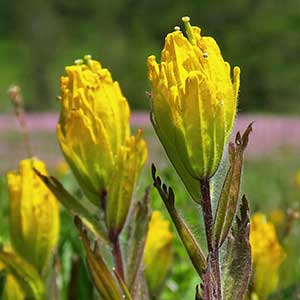Castilleja levisecta
Castilleja cusickii
golden Indian paintbrush, golden paintbrush
Cusick's Indian paintbrush, Cusick's paintbrush
few to many, erect, ± decumbent or creeping at base, unbranched, sometimes branched, hairs spreading, medium length and long, soft, mixed with short stipitate-glandular ones.
solitary or few to several, erect, often decumbent at base, unbranched, sometimes branched, hairs spreading, long, soft, eglandular, mixed with shorter, sometimes stiff, stipitate-glandular ones.
green to purple or brown-tinged, linear-lanceolate proximally, oblong-ovate or -obovate distally, 0.8–5.2 cm, not fleshy, margins plane, distalmost sometimes ± wavy, involute, 3–7(–11)-lobed, apex obtuse;
lobes erect to ascending, linear to linear-spatulate, very short, toothlike, usually arising from distal 1/3 of blade, apex rounded.
green, sometimes with prominent red-purple veins, lanceolate-linear to broadly lanceolate, 2.5–4.5(–7) cm, not fleshy, margins plane, flat, (0–)3–5(–9)-lobed, apex acuminate to acute;
lobes spreading-ascending, narrowly lanceolate, arising at or above mid length, apex acute.
2.5–25 × 1–4 cm;
bracts bright yellow throughout, or proximally greenish, distally bright yellow, sometimes deep yellow-orange, especially with age, oblong, elliptic, or obtuse to ovate, (0–)5–9(–13)-lobed, sometimes wavy-margined;
lobes erect to ascending, oblong, short to medium length, arising above mid length, central lobe apex rounded, lateral ones rounded to acute.
3.5–26 × 1.5–3.5 cm;
bracts pale green, pale greenish yellow, or pale yellow throughout, or proximally pale green, pale greenish yellow, pale yellow, or reddish purple, distally white, yellow, pink, dull purple, or dull reddish purple, sometimes with a purple band below that, sometimes with veins darker than background color, lanceolate to oblong, 0–5(–9)-lobed;
lobes ascending or spreading, linear to narrowly lanceolate, often short, arising above mid length, central lobe apex rounded, lateral ones acute to rounded.
straight or slightly curved, 17–28 mm;
tube 12–15 mm;
beak exserted, adaxially green or greenish yellow, 6–8 mm;
abaxial lip yellow or greenish, reduced, not inflated, 2–3 mm, 25–33(–50)% as long as beak;
teeth ascending to erect, yellow, 0.5–1.5 mm.
straight, 19–25(–28) mm;
tube (13–)15–20 mm;
abaxial lip included, beak not or slightly exserted;
beak adaxially green to yellow-green, 4–7 mm;
abaxial lip yellow, prominent, inflated, 2–4.5 mm, ca. 75% as long as beak;
teeth incurved to erect, white, 1.3–2.1 mm.
distally yellow, 13–22 mm;
abaxial and adaxial clefts 4–9.5 mm, 30–40% of calyx length, deeper than laterals, lateral 2.5–4.5 mm, ca. 25% of calyx length;
lobes linear to narrowly oblong or narrowly lanceolate, apex obtuse, sometimes rounded to acute.
green, pale green, or pale yellow, lobes yellow to pale yellow, 20–30 mm;
abaxial and adaxial clefts 6.6–14 mm, 33–50% of calyx length, deeper than laterals, lateral 0–4(–4.5) mm, 0–15% of calyx length;
lobes broadly rounded to triangular, apex obtuse to rounded.
= 24.
= 24.
Castilleja levisecta
Castilleja cusickii
Castilleja levisecta is listed as threatened in the United States and endangered in Canada, where it is extremely rare. Most of its grassland habitat has been altered by development in the Puget Trough, and there are historical stations in the metro areas of what are now Victoria, Portland, and Seattle. For several decades, C. levisecta was considered extirpated from Oregon. However, recent reintroduction programs in Oregon and Washington have been very successful at reestablishing this species at several sites in the Willamette Valley. The bright yellow inflorescences often gradually age to a golden yellow color, unique in the genus.
Castilleja levisecta is in the Center for Plant Conservation’s National Collection of Endangered Plants.
(Discussion copyrighted by Flora of North America; reprinted with permission.)
Castilleja cusickii includes two morphologically distinct variants. One variant has a wider inflorescence, broader bracts, and wider bract lobes. These bracts often have highly contrasting purple veins, and some populations also have a purplish wash on the bracts. These plants have a range on the western edge of typical C. cusickii, though overlapping with more typical forms in western Idaho and adjacent northeastern Oregon and southeastern Washington. The name C. lutea is available for these variants, and both consistent morphological differences and preliminary results from ongoing genetic research on the plants (D. C. Tank, pers. comm.) indicate its resurrection may be justified. A second variant is distinguished by a pale pink-purple wash on the bracts and a narrow distribution in the meadows of the Bear River Valley, bordering northwestern Utah and adjacent southeastern Idaho. Only bract coloration appears to distinguish this form from typical C. cusickii, and the distinctive bract coloration is only more or less consistent in these populations.
Typical Castilleja cusickii appears to hybridize with C. gracillima in the Logan Valley, Grant County, Oregon. It is also reported by M. Ownbey (1959) to hybridize with C. miniata and C. rhexiifolia.
(Discussion copyrighted by Flora of North America; reprinted with permission.)


